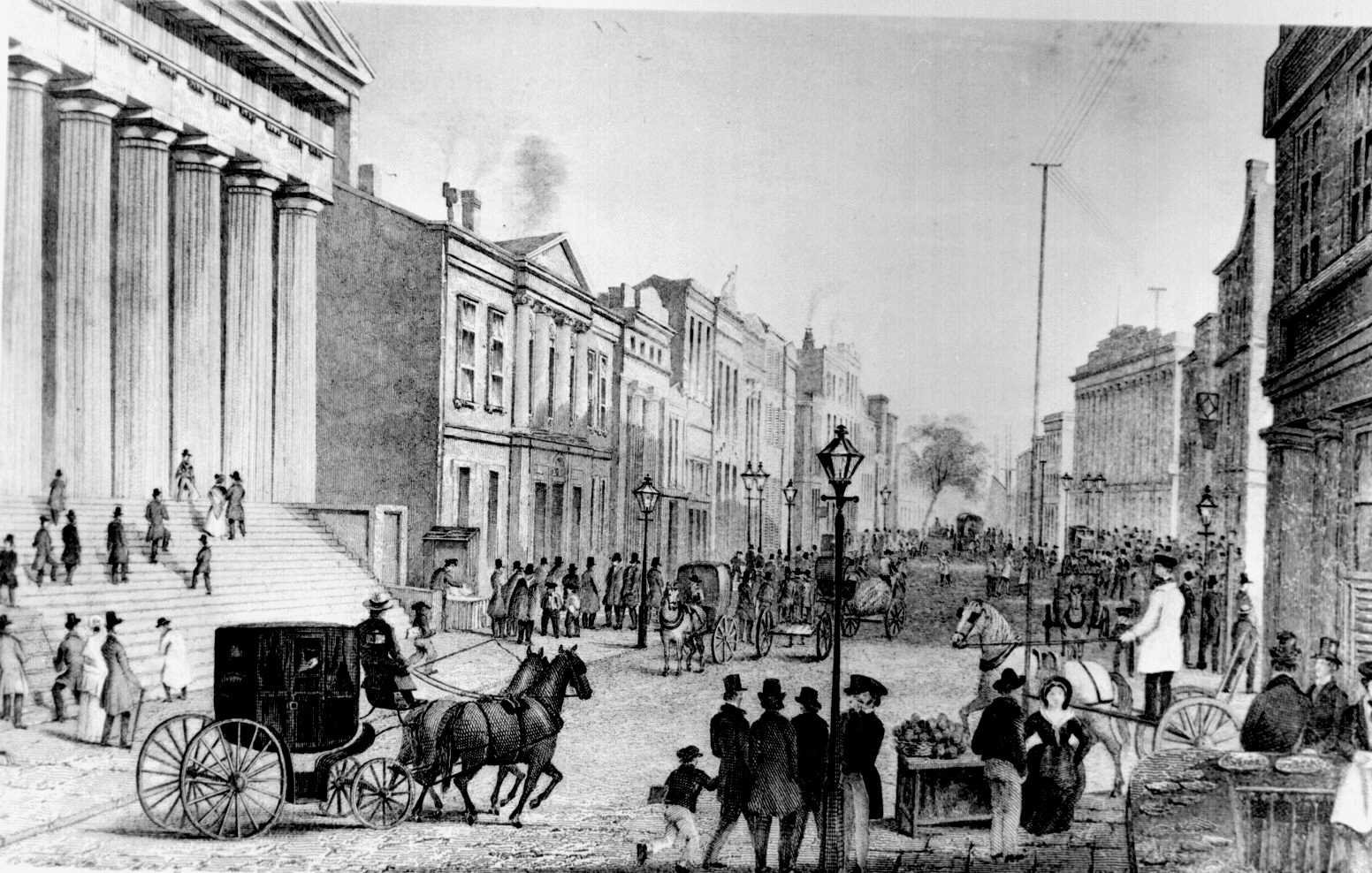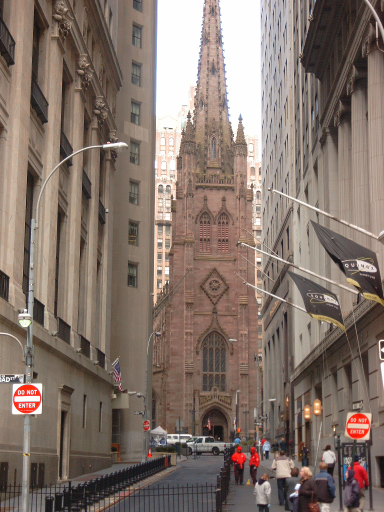Diferenças entre edições de "Wall Street"
| Linha 19: | Linha 19: | ||
Construído em 1914, o nº 23 de Wall Street é conhecido como a "Casa de Morgan" e foi durante décadas o mais importante endereço na finança Americana, servindo como sede da JP Morgan. Ao meio dia de 16 de Setembro de 1920, uma bomba explodiu em frente ao banco, matando 38 pessoas e ferindo 300. Pouco tempo depois desta bomba ter explodido, foi deixada uma nota de aviso numa caixa de correio da Cedar Street com a Broadway. Embora as teorias sobre as razões e quem esteve por trás do atentado abundem, após 20 anos de investigação, o FBI arquivou o dossier em 1940 sem nunca determinar os culpados. | Construído em 1914, o nº 23 de Wall Street é conhecido como a "Casa de Morgan" e foi durante décadas o mais importante endereço na finança Americana, servindo como sede da JP Morgan. Ao meio dia de 16 de Setembro de 1920, uma bomba explodiu em frente ao banco, matando 38 pessoas e ferindo 300. Pouco tempo depois desta bomba ter explodido, foi deixada uma nota de aviso numa caixa de correio da Cedar Street com a Broadway. Embora as teorias sobre as razões e quem esteve por trás do atentado abundem, após 20 anos de investigação, o FBI arquivou o dossier em 1940 sem nunca determinar os culpados. | ||
| − | [[Image:Crowd outside nyse.jpg|left|thumb|251px| | + | [[Image:Crowd outside nyse.jpg|left|thumb|251px|Uma multidão junta-se no cruzamento da Wall Street com a Broad Street, após o crash de 1929.]] |
| − | 1929 | + | 1929 trouxe o "[[Crash de 1929]]" do mercado accionista, marcando o início da [[Grande depressão]]. Durante esta época, o desenvolvimento do distrito financeiro estagnou. A construção do World Trade Center foi um dos poucos grandes projectos desenvolvidos nos últimos 3 quartos do século XX, e financeiramente não teve o sucesso esperado. |
| − | + | Ainda assim, algumas firmas de renome compraram espaço do WTC, além deste ter atraído outros negócios relevantes para a sua proximidade. Poder-se-ia argumentar que o WTC alterou o centro do distrito financeiro de Wall Street para o seu complexo. Quando o WTC foi destruído nos ataques de 11 de Setembro de 2001, estes levaram a algum dispersar do negócio de Wall Street, com alguma transferência de negócios para New Jersey, Chicago e Boston. | |
Wall Street itself and the Financial District as a whole are crowded with highrises by any measure. Further, the loss of the World Trade Center has actually spurred development in the Financial District on a scale that hadn't been seen in decades. This is in part due to tax incentives provided by the federal, state and local governments to encourage development. A new World Trade Center complex, centered on [[Daniel Liebeskind]]'s [[Memory Foundations]] plan, is in the early stages of development and one building has already been replaced. The centerpiece to this plan is the {{convert|1776|ft|m|0|sing=on}} tall [[Freedom Tower]]. New residential buildings are already sprouting up, and buildings that were previously office space are being converted to residential units, also benefiting from the tax incentives. Better access to the Financial District is planned in the form of a new commuter rail station and a new downtown transportation center centered on [[Fulton Street (Manhattan)|Fulton Street]]. | Wall Street itself and the Financial District as a whole are crowded with highrises by any measure. Further, the loss of the World Trade Center has actually spurred development in the Financial District on a scale that hadn't been seen in decades. This is in part due to tax incentives provided by the federal, state and local governments to encourage development. A new World Trade Center complex, centered on [[Daniel Liebeskind]]'s [[Memory Foundations]] plan, is in the early stages of development and one building has already been replaced. The centerpiece to this plan is the {{convert|1776|ft|m|0|sing=on}} tall [[Freedom Tower]]. New residential buildings are already sprouting up, and buildings that were previously office space are being converted to residential units, also benefiting from the tax incentives. Better access to the Financial District is planned in the form of a new commuter rail station and a new downtown transportation center centered on [[Fulton Street (Manhattan)|Fulton Street]]. | ||
Revisão das 10h43min de 28 de dezembro de 2008
| |
|
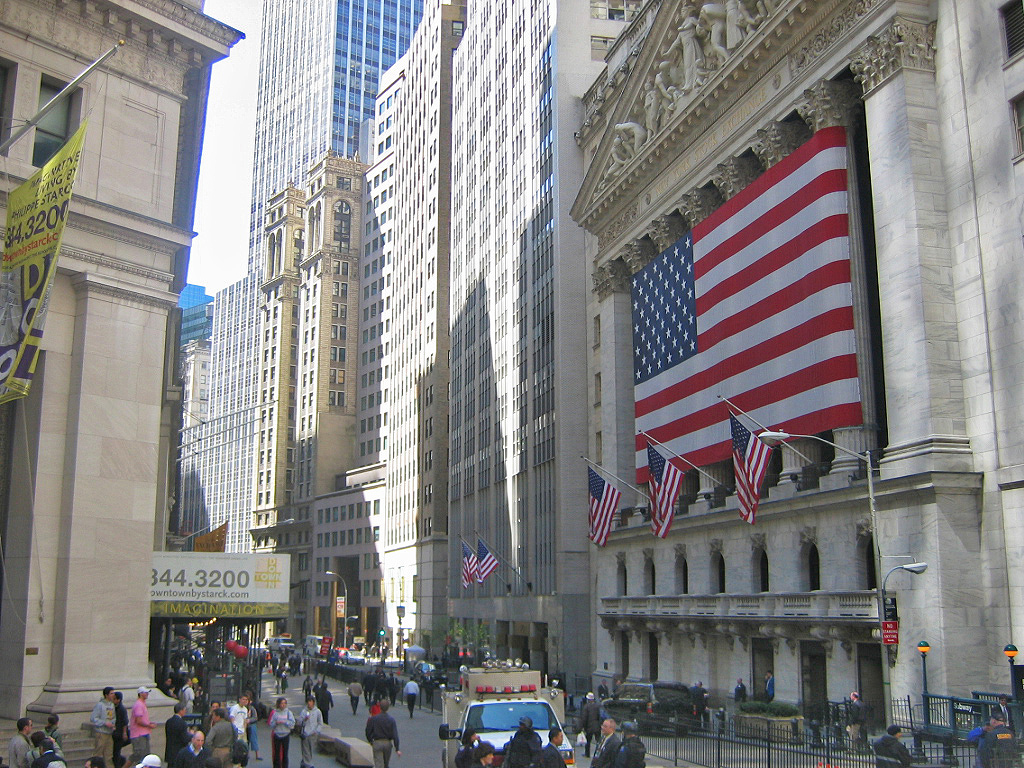 Wall Street é uma rua em Manhattan, Nova Yorque, nos EUA. Esta rua extende-se da Broadway à South Street em East River, passando pelo centro histórico do distrito financeiro. A Wall Street foi a primeira sede permanente da New York Stock Exchange; ao longo do tempo Wall Street passou também a ser o nome do bairro circundante. Também ao longo do tempo, Wall Street tornou-se um sinónimo para a indústria financeira Americana.
Wall Street é uma rua em Manhattan, Nova Yorque, nos EUA. Esta rua extende-se da Broadway à South Street em East River, passando pelo centro histórico do distrito financeiro. A Wall Street foi a primeira sede permanente da New York Stock Exchange; ao longo do tempo Wall Street passou também a ser o nome do bairro circundante. Também ao longo do tempo, Wall Street tornou-se um sinónimo para a indústria financeira Americana.
Índice
História
O nome da rua deriva do facto de que durante o século XVII, Wall Street constituía a fronteira norte de Nova Amsterdam. Nessa altura (1640s), cercas básicas delimitavam propriedades e residências na colónia. Mais tarde, Peter Stuyvesant, parcialmente usando escravos Africanos, construiu uma barreira, ou muro, mais sofisticado, usando madeira e terra. Este muro foi criado, e melhorado ao longo do tempo, para servir como defesa contra ataques de variadas tribos de nativos Americanos, colonos e Britânicos. Em 1685, Wall Street foi estabelecida ao longo deste muro. O muro foi desmantelado pelos Britânicos em 1699.
No final do século XVIII, existia uma árvore, um Plátano, no final da Wall Street, debaixo da qual os traders e especuladores se juntavam para transaccionar informalmente entre si. Em 1792, os traders formalizaram a sua associação com o Acordo de Buttonwood. Esta seria a origem da New York Stock Exchange.
Em 1889, o relatório original sobre as transacções de acções, o Customers' Afternoon Letter, tornou-se no The Wall Street Journal, assim designado em referência à própria rua, tendo-se entretanto tornado no diário de negócios mais influente do mundo. Durante muitos anos, o WSJ teve a maior circulação de qualquer diário nos EUA, embora tenha entretanto perdido essa posição para o USA Today. O WSJ é propriedade da News Corp de Rupert Murdoch desde 2007.
Declínio e revitalização
O distrito financeiro de Manhattan é um dos grandes centros de negócios dos EUA. No final do século XIX e início do século XX, a cultura corporativa de Nova Yorque foi uma fonte de incentivo para a construção de arranha-céus rivalizada apenas por Chicago.
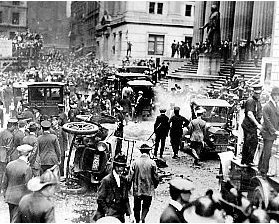 Construído em 1914, o nº 23 de Wall Street é conhecido como a "Casa de Morgan" e foi durante décadas o mais importante endereço na finança Americana, servindo como sede da JP Morgan. Ao meio dia de 16 de Setembro de 1920, uma bomba explodiu em frente ao banco, matando 38 pessoas e ferindo 300. Pouco tempo depois desta bomba ter explodido, foi deixada uma nota de aviso numa caixa de correio da Cedar Street com a Broadway. Embora as teorias sobre as razões e quem esteve por trás do atentado abundem, após 20 anos de investigação, o FBI arquivou o dossier em 1940 sem nunca determinar os culpados.
Construído em 1914, o nº 23 de Wall Street é conhecido como a "Casa de Morgan" e foi durante décadas o mais importante endereço na finança Americana, servindo como sede da JP Morgan. Ao meio dia de 16 de Setembro de 1920, uma bomba explodiu em frente ao banco, matando 38 pessoas e ferindo 300. Pouco tempo depois desta bomba ter explodido, foi deixada uma nota de aviso numa caixa de correio da Cedar Street com a Broadway. Embora as teorias sobre as razões e quem esteve por trás do atentado abundem, após 20 anos de investigação, o FBI arquivou o dossier em 1940 sem nunca determinar os culpados.
 1929 trouxe o "Crash de 1929" do mercado accionista, marcando o início da Grande depressão. Durante esta época, o desenvolvimento do distrito financeiro estagnou. A construção do World Trade Center foi um dos poucos grandes projectos desenvolvidos nos últimos 3 quartos do século XX, e financeiramente não teve o sucesso esperado.
1929 trouxe o "Crash de 1929" do mercado accionista, marcando o início da Grande depressão. Durante esta época, o desenvolvimento do distrito financeiro estagnou. A construção do World Trade Center foi um dos poucos grandes projectos desenvolvidos nos últimos 3 quartos do século XX, e financeiramente não teve o sucesso esperado.
Ainda assim, algumas firmas de renome compraram espaço do WTC, além deste ter atraído outros negócios relevantes para a sua proximidade. Poder-se-ia argumentar que o WTC alterou o centro do distrito financeiro de Wall Street para o seu complexo. Quando o WTC foi destruído nos ataques de 11 de Setembro de 2001, estes levaram a algum dispersar do negócio de Wall Street, com alguma transferência de negócios para New Jersey, Chicago e Boston.
Wall Street itself and the Financial District as a whole are crowded with highrises by any measure. Further, the loss of the World Trade Center has actually spurred development in the Financial District on a scale that hadn't been seen in decades. This is in part due to tax incentives provided by the federal, state and local governments to encourage development. A new World Trade Center complex, centered on Daniel Liebeskind's Memory Foundations plan, is in the early stages of development and one building has already been replaced. The centerpiece to this plan is the Predefinição:Convert tall Freedom Tower. New residential buildings are already sprouting up, and buildings that were previously office space are being converted to residential units, also benefiting from the tax incentives. Better access to the Financial District is planned in the form of a new commuter rail station and a new downtown transportation center centered on Fulton Street.
Wall Street's culture is often criticized as being rigid. This is a decades-old stereotype stemming from the Wall Street's establishment's protection of their interests, and the link to the WASP establishment. More recent criticism has centered on structural problems and lack of a desire to change well-established habits. Wall Street's establishment resists government oversight and regulation. At the same time, New York City has a reputation as a very bureaucratic city, which makes entry into the neighborhood difficult or even impossible for middle class entrepreneurs.
Since the founding of the Federal Reserve banking system, the Federal Reserve Bank of New York in the Financial District has been the point where monetary policy in the United States is implemented (although it is decided in Washington, D.C. by the Federal Reserve Bank's Board of Governors). As such, New York State is today unique in that it is the only state that constitutes its own district of the Federal Reserve Banking system. This is perhaps partly owed to population distribution in the United States of the time, however. Until the 1960s, New York was the most populated state in the U.S.; it now ranks third, behind California and Texas. The NY Federal Reserve's president is the only regional Bank president with a permanent vote and is traditionally selected as its vice chairman. The bank has a gold vault 80 feet (25 m) beneath the street. This depository is the largest in the world, larger even than Fort Knox.
Buildings
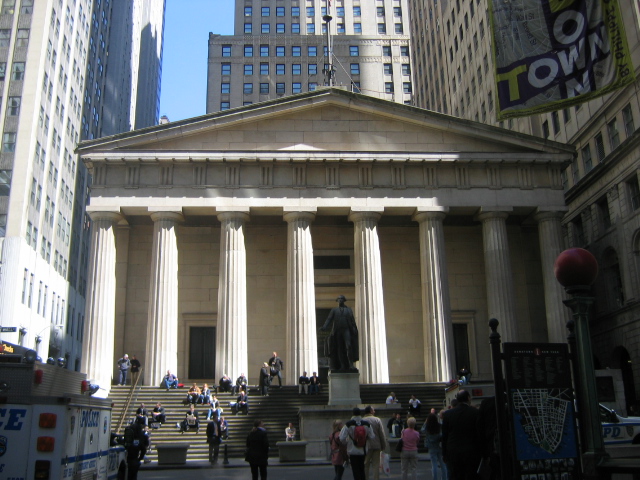 Wall Street's architecture is generally rooted in the Gilded Age, though there are also some art deco influences in the neighborhood. Landmark buildings on Wall Street include Federal Hall, 14 Wall Street (Bankers Trust Company Building), 40 Wall Street (The Trump Building), and the New York Stock Exchange at the corner of Broad Street.
Wall Street's architecture is generally rooted in the Gilded Age, though there are also some art deco influences in the neighborhood. Landmark buildings on Wall Street include Federal Hall, 14 Wall Street (Bankers Trust Company Building), 40 Wall Street (The Trump Building), and the New York Stock Exchange at the corner of Broad Street.
Personalities
Over the years, certain elite persons associated with Wall Street have become famous. Although their reputations are usually limited to members of the stock brokerage and banking communities, several have gained national and international fame. Some earned their fame for their investment strategies, financing, reporting, legal or regulatory skills, while others are remembered for their greed. One of the most iconic representations of the market prosperity is the Charging Bull sculpture, by Arturo Di Modica. Representing the bull market economy, the sculpture was originally placed in front of the New York Stock Exchange, and subsequently moved to its current location in Bowling Green.
Cultural influence
Wall Street vs. Main Street
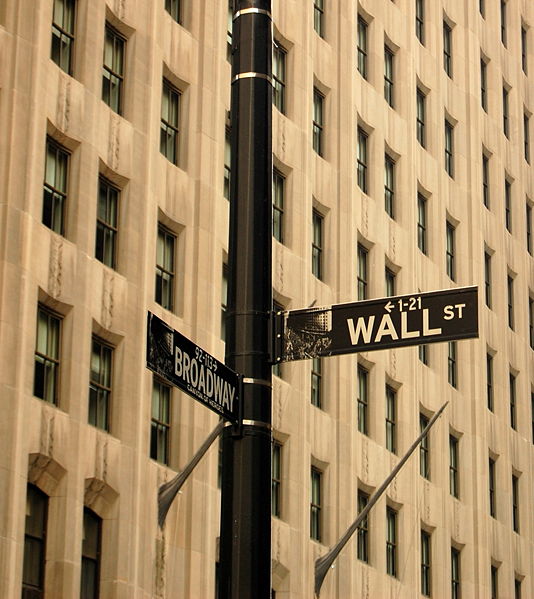
Perceptions
The older skyscrapers often were built with elaborate facades; such elaborate aesthetics haven't been common in corporate architecture for decades. The World Trade Center, built in the 1970s, was very plain and utilitarian in comparison (the Twin Towers were often criticized as looking like two big boxes, despite their impressive height).
Wall Street, more than anything, represents financial and economic power. To Americans, Wall Street can sometimes represent elitism and power politics and cut-throat capitalism, but it also stirs feelings of pride about the market economy. Wall Street became the symbol of a country and economic system that many Americans see as having developed not through colonialism and plunder, but through trade, capitalism, and innovation.<ref>Fraser (2005).</ref>
In popular culture
- Herman Melville's classic short story Bartleby the Scrivener is subtitled A Story of Wall Street and provides an excellent portrayal of a kind and wealthy lawyer's struggle to reason with that which is unreasonable as he is pushed beyond his comfort zone to "feel" something real for humanity.
- In William Faulkner's novel The Sound and the Fury, Jason Compson hits on other perceptions of Wall Street: after finding some of his stocks are doing poorly, he blames the Jews.
- On January 26, 2000, the band Rage Against The Machine filmed the music video for "Sleep Now in the Fire" on Wall Street, which was directed by Michael Moore. The band at one point stormed the Stock Exchange, causing the doors of the Exchange to be closed early (2:52 P.M.). Trading on the Exchange floor, however, continued uninterrupted.<ref>Basham, David (2000-01-28). Rage Against The Machine Shoots New Video With Michael Moore. MTV News. Consultado a 2007-09-24.</ref><ref>NYSE special closings since 1885 (PDF). Consultado a 2007-09-24.</ref>
- The film Wall Street exemplifies many popular conceptions of Wall Street, being a tale of shady corporate dealings and insider trading.<ref>IMDb entry for Wall Street Retrieved 19 August 2006.</ref>
- In the film National Treasure a clue to finding the Templar Treasure leads the main characters to Wall Street's Trinity Church.
- TNA Wrestler Robert Roode is billed from "Wall Street in Manhattan, New York".
Ver também
Notas
Referências
- Atwood, Albert W. and Erickson, Erling A. "Morgan, John Pierpont, (Apr. 17, 1837 - Mar. 31, 1913)," in Dictionary of American Biography, Volume 7 (1934)
- Carosso, Vincent P. The Morgans: Private International Bankers, 1854-1913. Harvard U. Press, 1987. 888 pp. ISBN 978-0674587298
- Carosso, Vincent P. Investment Banking in America: A History Harvard University Press (1970)
- Chernow, Ron. The House of Morgan: An American Banking Dynasty and the Rise of Modern Finance, (2001) ISBN 0-8021-3829-2
- Fraser, Steve. Every Man a Speculator: A History of Wall Street in American Life HarperCollins (2005)
- Geisst; Charles R. Wall Street: A History from Its Beginnings to the Fall of Enron. Oxford University Press. 2004. online edition
- John Moody; The Masters of Capital: A Chronicle of Wall Street Yale University Press, (1921) online edition
- Morris, Charles R. The Tycoons: How Andrew Carnegie, John D. Rockefeller, Jay Gould, and J. P. Morgan Invented the American Supereconomy (2005) ISBN 978-0805081343
- Perkins, Edwin J. Wall Street to Main Street: Charles Merrill and Middle-class Investors (1999)
- Robert Sobel The Big Board: A History of the New York Stock Market (1962)
- Robert Sobel The Great Bull Market: Wall Street in the 1920s (1968)
- Robert Sobel Inside Wall Street: Continuity & Change in the Financial District (1977)
- Strouse, Jean. Morgan: American Financier. Random House, 1999. 796 pp. ISBN 978-0679462750
